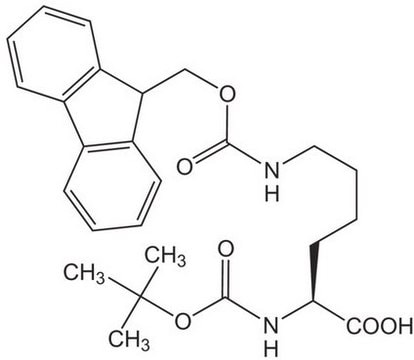8.52346
Fmoc-Sec(pMeOBzl)-OH
≥98.0% (HPLC), for peptide synthesis, Novabiochem®
Synonim(y):
Fmoc-Sec(pMeOBzl)-OH, Fmoc-Sec(Mob)-OH,Fmoc-S-4-methoxybenzyl selenocysteine
About This Item
Polecane produkty
product name
Fmoc-Sec(pMeOBzl)-OH, Novabiochem®
Poziom jakości
linia produktu
Novabiochem®
Próba
≥98% (TLC)
≥98.0% (HPLC)
Postać
powder
przydatność reakcji
reaction type: Fmoc solid-phase peptide synthesis
producent / nazwa handlowa
Novabiochem®
Zastosowanie
peptide synthesis
grupa funkcyjna
Fmoc
temp. przechowywania
2-8°C
InChI
1S/C26H25NO5Se/c1-31-18-12-10-17(11-13-18)15-33-16-24(25(28)29)27-26(30)32-14-23-21-8-4-2-6-19(21)20-7-3-5-9-22(20)23/h2-13,23-24H,14-16H2,1H3,(H,27,30)(H,28,29)/t24-/m0/s1
Klucz InChI
XCPAYIZRJRMXBI-DEOSSOPVSA-N
Powiązane kategorie
Opis ogólny
Associated Protocols and Technical Articles
Cleavage and Deprotection Protocols for Fmoc SPPS
Literature references
[1] T. Koide, et al. (1993) Chem. Pharm. Bull., 41, 502.
[2] T. Koide, et al. (1993) Chem. Pharm. Bull., 41, 1596.
[3] D. Besse & L. Moroder (1997) J. Peptide Sci., 3, 442.
Komentarz do analizy
Appearance of substance (visual): powder
Identity (IR): passes test
Enantiomeric purity: ≥ 99.5 % (a/a)
Purity (TLC(157A)): ≥ 98 %
Assay (HPLC, area%): ≥ 98.0 % (a/a)
Solubility (1 mmole in 2 ml DMF): clearly soluble
To see the solvent systems used for TLC of Novabiochem® products please click here.
Informacje prawne
Hasło ostrzegawcze
Danger
Zwroty wskazujące rodzaj zagrożenia
Zwroty wskazujące środki ostrożności
Klasyfikacja zagrożeń
Acute Tox. 3 Inhalation - Acute Tox. 3 Oral - Aquatic Acute 1 - Aquatic Chronic 1 - Skin Irrit. 2 - STOT RE 2 - STOT SE 3
Organy docelowe
Respiratory system
Kod klasy składowania
6.1C - Combustible, acute toxic Cat.3 / toxic compounds or compounds which causing chronic effects
Klasa zagrożenia wodnego (WGK)
WGK 3
Temperatura zapłonu (°F)
Not applicable
Temperatura zapłonu (°C)
Not applicable
Certyfikaty analizy (CoA)
Poszukaj Certyfikaty analizy (CoA), wpisując numer partii/serii produktów. Numery serii i partii można znaleźć na etykiecie produktu po słowach „seria” lub „partia”.
Masz już ten produkt?
Dokumenty związane z niedawno zakupionymi produktami zostały zamieszczone w Bibliotece dokumentów.
Nasz zespół naukowców ma doświadczenie we wszystkich obszarach badań, w tym w naukach przyrodniczych, materiałoznawstwie, syntezie chemicznej, chromatografii, analityce i wielu innych dziedzinach.
Skontaktuj się z zespołem ds. pomocy technicznej











